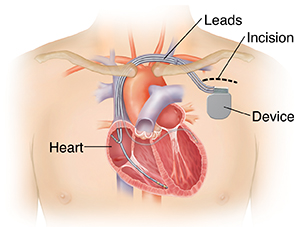Having Cardiac Resynchronization Therapy (CRT)
Having Cardiac Resynchronization Therapy (CRT)
Your healthcare provider recommends that you have cardiac resynchronization therapy (CRT). This is a procedure to place a small device in your chest and wires in your heart. CRT improves the timing of your heart’s contractions. This helps your heart pump better. CRT can be done with a pacemaker or a defibrillator. Your healthcare provider will decide which device is better for you.
Talk with your healthcare provider about any questions or concerns you have before the procedure. The procedure takes about 1 to 3 hours. You will stay in the hospital overnight. This is to make sure the device is working properly and to check your incision. Most people return to their normal routine a few weeks after the procedure. Here’s what to expect before, during, and after the procedure.
Before the procedure
Before your procedure you may have certain tests. You may have a cardiac catheterization, an electrocardiogram (ECG or EKG) and a stress test using electrocardiogram. You may also have an echocardiogram (echo). These tests tell your healthcare provider about your heart’s function and whether CRT is right for you.
You may need to stop taking certain medicines several days before the procedure. This includes medicines that thin your blood. If you take medicines for diabetes, you may need to change your dose before and after the procedure or even stop some altogether. Talk with your healthcare provider.
You will not be able to eat or drink a certain number of hours before surgery. If you take medicines in the morning, ask your healthcare provider if you can take them with a sip of water.
Let your healthcare provider know about:
All prescription medicines that you take
All over-the-counter medicines you take, such as aspirin
All herbs, vitamins, or other supplements you take
Any allergies you have
Any history of kidney disease
Any recent symptoms of colds or infections
Any history of problems with anesthesia
Pregnancy or suspected pregnancy
During the procedure
You’ll be sedated during the procedure using pain medicine and sedatives. Rarely is general anesthesia used. During the procedure:
You lie down on an X-ray table in a special lab. An intravenous (IV) line is put in your arm or hand. This is a thin, flexible tube. It lets your doctor give you medicines to make you relax and to prevent pain.
Monitors and sensors are put on your body to check your heart, blood pressure, and blood oxygen level.
The iwill be shaved, if needed, and cleansed with antiseptic solution.
A local anesthetic, or numbing medicine, is injected into your chest below your collarbone.
Your doctor will make an incision about 2 inches long in the skin of your chest.
The doctor then inserts the device wires, called leads, into a large vein that sends blood to your heart. The wires are guided into your heart. Special live X-rays (called fluroscopy) are taken to make sure the leads are in the right place on both sides of the heart.
The leads are then tested to be sure everything is connected and working properly. This may feel as if your heart is racing.
If the leads are in the right place and working, they are attached to the CRT device (pacemaker or defibrillator). The device is put through the incision and under your skin.
Your healthcare provider will then close the incision with sutures, staples, or surgical glue. He or she will then apply a dressing.
After the procedure
You will go to the recovery area, where you'll stay until the sedative medicine has worn off. A healthcare provider will give you pain medicine as needed. You will need to stay in the hospital overnight. This is so your healthcare provider can check and adjust the settings on your CRT device and monitor your incision site. After you leave the hospital, follow all of your healthcare provider's advice. Your doctor will give you specific instructions on how to care for your incision. You will also need to limit how you move your arms for a certain period of time. Your doctor will monitor your CRT device regularly. Keep all follow-up appointments.
Updated:
October 27, 2017
Sources:
Cardiac resynchronization therapy in heart failure: Implantation and other considerations, Up To Date, Minor wound repair with tissue adhesives, Up To Date
Reviewed By:
Image reviewed by StayWell medical illustration team.,Kang, Steven, MD,Snyder, Mandy, APRN
